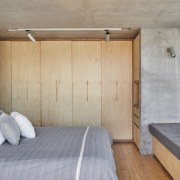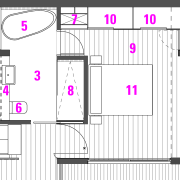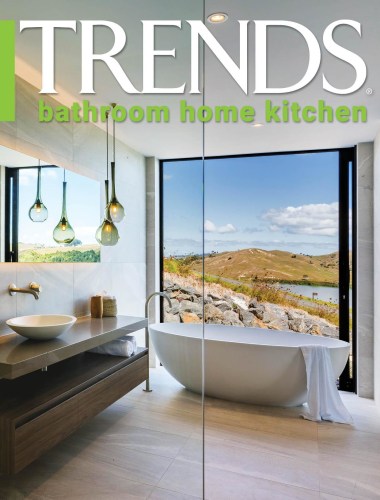In keeping with the rest of the highly contemporary home, this master ensuite-meets-family bathroom offers a strong, clean-lined architectural presence
Extending into a sculptural atrium one way, this bathroom responds to its wider setting in both its semi-industrial aesthetic and strong material choices
Not all family bathrooms seek to emulate the soft, pastel-toned luxury of a resort-style retreat. Instead, some reflect a stronger, more sculptural presence – this bathroom sits in the latter camp.
Part of a whole-house renovation, this bathroom has a central position and serves as both the family bathroom and master ensuite, says architect David Haseler, who co-designed the makeover with architect Angela Rheinlaender.
“The contemporary bathroom transitions seamlessly into its wider surroundings, in terms of both materials and design,” says Haseler.
And the bathroom’s location is as dramatic as it is central. It hovers over and forms part of a 9m-high, top-lit atrium. Making the most of this situation, panel shutters in the bathroom can be opened to overlook the atrium.
“Bringing in natural light and ventilation, the shutters also allow someone in the bath to look out on the activity of the house or to take in more distant views,” says Rheinlaender.

When the shutters are closed, natural light is still achieved via high-level glazing to the side of them.
The home’s simple, reduced material palette is continued into the bathroom space. Elements such as off-form concrete columns and ceilings, plywood, white-laminated benchtops, glass and Ferrodor-painted steel shelves are supplemented with dark porcelain tiles and custom linear drain grates. The dark tiles also form a neutral backdrop to the white porcelain bathroomware.
The bathroom’s layout is as simple as the materials used. The tub is at one end, with the vanity and toilet to one side and the walk-in glass shower on the other.
The bedroom is on the other side of the shower wall and can be reached easily from both ends of the bathroom.
Behind the bathroom’s simplicity of design and materials lies plenty of integrated, mainly hidden technology. Elements include heat-pump driven hot water, a toilet serviced by rainwater harvesting, and silent-technology exhaust fans. The fans are concealed in the wall.

Beyond the bathroom, a laundry chute is handily located within the linen cupboard that links through to the master bedroom. The linen cupboard forms the transition to the custom plywood robe in the master bedroom proper.
“In fact, there are three joinery items in the master bedroom – the custom robe, a plywood cupboard with open shelves, and a window seat with storage, also in plywood,” says Haseler.
A low-energy-use hydronic convection heater is also tucked away in the window seat.
The north-facing master bedroom opens up to a generous terrace garden and achieves solar control through modern sliding grating screens and a large, mature deciduous tree.
“Lighting was also an important part of the ambience,” says Rheinlaender.
“Concealed strip lighting in the bathroom gives way to aluminium track lighting over the robe in the bedroom.”
Further lighting comes from an aluminium extrusion in the master bedroom bedhead.
Credit list
Architect
Structural Engineer
Joinery
Basin
Bath
Shower fittings
Accessories
Bathroom wall finishes
Underfloor heating
Awards
Lighting designer
Sustainability consultant
Vanity manufacturer
Benchtop/splashback
Shower stall
Toilet
Lighting
Hot water system
Story by: Charles Moxham
Photography by: John Gollings and Robert Gray
Home kitchen bathroom commercial design
Reflection and repose
9 tile shapes and finishes that think outside the square
Curves upon curves
Home Trends Vol. 36/1
While a bathroom may no longer be regarded as 'the smallest room' in a home, the extra space now allocated to it doesn't...
Read More








